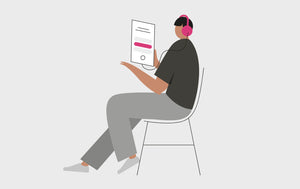Binaural Benefits
The benefits of using two hearing aids
Human hearing is designed for two ears. The technical term is binaural listening, and the auditory system is wired for it to allow for the best possible hearing and understanding.
If a hearing professional evaluates that you have hearing loss in both ears, the recommendation will usually be to wear two hearing aids. However, it’s all too often the case that people try to ‘get by’ with just a single hearing aid, maybe to reduce costs or simply because they feel that they only need to wear a device in the ear with the greater degree of hearing loss.
Whatever the reason, restricting yourself to a single hearing aid is a false economy because the truth is that one simply cannot do the job of two.
Your ears ‘talk’ directly to your brain
Our two ears and the two halves of our brain all work together to create what is known as auditory awareness. Each ear sends the different sound signals it collects to your brain via neural pathways, and the brain interprets those two sets of signals to enable us to understand and react to the world around us. It’s how we know someone is speaking to us; it’s how we know that a car is approaching us, say, from the left-hand side of our body; it’s how we gauge the kind of environment we’re in. For example, the ambient sounds in a carpeted living room sound completely different from the ‘echo chamber’ of a swimming pool.
Our brains are designed to listen in stereo as our default position – that’s the natural way we’re supposed to hear, and it’s the reason why listening to music in stereo just sounds better than in mono. It’s not just that the music sounds richer and fuller in stereo… if our brain doesn’t get the full audio picture from both sides, things don’t sound right and we miss out on vital areas of perception.
So using one hearing aid when two are really needed means that the brain won’t get the full input it needs. And the results are more significant than you might imagine.
Separate the voice from noise and enjoy more relaxed listening
With only one hearing aid, noises blend together and it becomes much more difficult to discriminate between the sounds you want to hear and those you don’t. Plus, the subconscious extra effort that the brain has to make in filtering out noise is proven to be very tiring.
Whereas, the stereo signals from two hearing aids help the brain to focus on the voice of the person who is speaking.
Stereo detection means better sound direction
Receiving sound signals from both ears lets the brain not only locate the source where sounds are coming from but also identify if the source of that sound is moving… and, if so, how fast. In a social situation, it’s vital to be able not only to switch attention between different people speaking in a group, but also to still be able to hear conversation from people on your left and right. It’s tiring to continually turn yourself around and point your ‘good ear’ at people.
From a safety perspective, being able to identify – in a fraction of a second – the sound of an approaching vehicle can make the difference between staying on the kerb or going to hospital! And in a driving scenario, it's also true that wearing two hearing aids will keep you better ‘in tune’ with your environment and the traffic around you.
Turn down the volume. Turn up the hearing
A common complaint that we at Hearing Direct hear from customers is that "Everything sounds too loud!" Now this is especially true when people are first getting used to wearing hearing aids – there’s a period of adjustment where the natural temptation is to turn everything up to 11 to ensure maximum benefit. And with just one hearing aid, there’s often an even greater temptation to turn up the volume to an uncomfortably high level in order to compensate.
Within a couple of days though, customers usually get the hang of using just enough volume to make the difference to their hearing without giving themselves a decibel-related headache.
By replicating the body’s natural design with two hearing aids rather than one, there’s even less reason to turn up the volume because you’re inputting twice the amount of signal; so you can keep them both at a lower volume and still hear adequately.
A quiet word about tinnitus
Hearing aids are frequently recommended to relieve the ringing in the ear associated with tinnitus, and they work extremely well for many tinnitus sufferers. However – and, yes, it sounds obvious –if you choose to limit yourself to one hearing aid, the ringing in the unaided ear may continue unchanged, and that’s a wasted opportunity to enjoy a world of relief.



